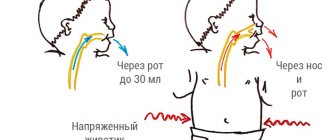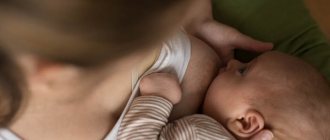Why is a baby anxious when breastfeeding?
The reason why a child behaves restlessly during breastfeeding may be physiological in nature, may be due to illness, or may have a psychological basis. This manifests itself in restless behavior at the breast: the child arches, taps his foot, and turns away from the breast. The probable reasons for a baby's restless behavior during breastfeeding can be varied.
Lack of milk
This is the very first reason that comes to mind for many mothers if the baby is nervous during feeding. Indeed, if the baby had eaten enough, he would have been calm. Since he is worried, it means that he is not satisfied with the amount of milk, therefore, he does not finish eating. This is what nursing mothers and their frequent assistants, grandmothers, think. Their experiences are understandable to some extent - when breastfeeding, it is difficult to measure how much milk the baby drank. Most often, fears and worries about a “hungry” baby are unfounded.
There are very specific indicators of child development. These include the following parameters:
- monthly weight gain - within 2 weeks after birth, the baby should regain its birth weight, and then gain approximately 600-800 g each month;
- regular urination and bowel movements - the “wet diaper” test should be tested at least 10 times a day, soiled diaper - 1-2 times a day;
- the child’s general satisfactory condition – activity during the day, absence of pale skin and signs of dehydration.
Breast swelling
It can occur in the first weeks after childbirth, when milk “rushes” and a feeling of fullness is created. Indeed, this can lead to anxiety for the baby, since he literally cannot latch on to the nipple. In such a situation, pumping will help. It is necessary to express some milk by hand or with a breast pump before feeding. The breast will become softer and the baby will be able to grasp the nipple. You only need to express a small amount so that milk production does not increase. Otherwise, next time there will be much more of it, and the problem will repeat.
The baby cannot latch onto the nipple due to breast swelling
Flat nipples
They can interfere with the process of “producing” milk, and the baby at the breast becomes nervous. This cosmetic defect can also be successfully dealt with: before feeding, express a little milk with a breast pump. It “pulls out” the depressed nipples and starts the flow of milk. The child will immediately receive the long-awaited food and successfully continue to eat instead of crying. You can also use special silicone nipple covers. There are two types: special pads for feeding and pads for wearing on the chest in between feedings. They precisely “pull out” the nipples.
Incorrect posture
Inconvenience when feeding causes concern not only for the child. The nursing mother herself experiences it. In this case, she may subconsciously shorten the feeding time in order to complete it as quickly as possible. The child should feel confident and calm, for this he must be pressed tightly, held by the shoulders and buttocks so that he does not slip when sucking. The baby's nose and chin should rest against the chest, then he will suck confidently and calmly. You can feed while lying down or holding the baby in your arms; this is done at will and convenience. The main thing is that the actors in the important process feel comfortable.
Uncomfortable posture can cause crying
Gastro-food reflux
This is a condition also called heartburn. A small amount of milk, along with gastric juice, flows back into the esophagus and causes discomfort. To stop the attack after feeding, the child must be held in an upright position. This also to some extent solves another problem - the baby will stop burping after eating.
Increased gas formation
Flatulence often bothers a newborn baby, and when breastfeeding the child freaks out. Due to its ease of absorption, breast milk quickly passes through the gastrointestinal tract. Characteristic sounds can be heard when the baby has not even finished sucking the breast. This is especially pronounced in the afternoon. Some foods that a nursing mother eats can increase flatulence. This applies to a greater extent to the group of legumes and various types of cabbage. In such a situation, it is important to monitor your diet and eat less of these dishes or temporarily eliminate them altogether.
Physiological lactase deficiency
This condition is caused by a lack of an enzyme found in hindmilk. It is rich in fats, which neutralize lactose and reduce flatulence. If a baby restlessly sucks at the breast or spends little time on it, he does not get to the “hind” milk, limiting himself only to the “front” milk. It is the “hind” milk that saturates the baby, has a calming effect and reduces anxiety. After a “hearty” meal, he is more likely to fall asleep.
A child chokes on milk
Under the influence of strong pressure, the baby chokes on milk at the breast. It is necessary to squeeze the breast strongly and stop the flow, and then give it to the baby again. Or express a little milk before feeding to reduce pressure. As the child grows up, he will learn to cope with any quantity and pressure of milk; he just needs help in the beginning to adapt to this physiological feature.
Smell
A pungent and unusual smell can displease a child, so much so that he refuses to eat. During lactation, it is recommended not to use creams, perfumes and aromatic soaps with strong fragrances, so as not to displease the baby.
Thrush
An infection in a baby's chest or mouth is called thrush, caused by Candida fungi. White spots appear in the baby's mouth, and there may be redness on the nipples. When feeding, unpleasant sensations appear - burning and itching. If you suspect an infection, you must seek qualified medical help and, if the diagnosis is confirmed, undergo a course of medication with your baby.
Important information! Many babies who are familiar with a pacifier or bottle latch on incorrectly. If the latch is incorrect, they are unable to obtain milk, as a result of which the desire to suckle disappears.
Incorrect attachment
Incorrect breastfeeding is a common mistake made by mothers. Therefore, if a woman is going to breastfeed for the first time, she needs to learn the basics of successful breastfeeding.
If applied incorrectly, the baby does not fully grasp the areola. The baby sucks only the nipple, which leads to the following:
- the breast is not completely emptied, creating the illusion of a lack of milk;
- the flow of fluid is large, and the newborn cannot cope with it and chokes;
- a woman develops cracks and bruises on her nipples;
- the mother experiences discomfort and even pain during feeding.
A characteristic sign of improper attachment is that during sucking the baby arches his back and throws his head back. With these actions the baby shows his protest. Reasons for incorrect application:
- flat or inverted nipples;
- use of pacifiers and bottles from the first days of the baby’s life;
- short bridle;
- neurological problems.
Every mother is capable of breastfeeding. To do this, you need to learn how to attach the baby correctly. With the correct position, the baby completely captures the areola, and his lower lip is turned outward. If the grip is incorrect, you need to carefully remove the nipple from the mouth (to do this, you need to carefully insert your finger into the corner of the baby’s mouth) and give it in a different way.
At the age of 2-3 months, the child understands that he is a separate person. The baby actively moves his arms and legs, trying to explore the world. Some three-month-old babies no longer like the fact that their mother presses her head with her hand while feeding. The baby arches, pushes away and blushes.
In such a situation, you should try other feeding positions. For example, put the baby on the bed and lie down next to him. This pose will also take the pressure off your arms and make mom's task easier.
If the newborn began to throw his head back and be indignant when sucking from the breast after a bottle, then he simply felt the difference. Liquid flows out of the bottle easily, but it has to be extracted from the chest. Therefore, often with mixed feeding, children give preference to a plastic accessory and refuse breastfeeding.
To avoid this problem, you need to completely switch to breastfeeding. If there are difficulties, you should take the advice of breastfeeding consultants.
The child behaves nervously when feeding
There may also be a situation where the child lost psychological contact with his mother and did not get the food he wanted when he was hungry (it’s just that it’s not time for mom’s lunch yet, because she lives according to the correct routine). It happens that a baby is taught to swim and dive in a bathtub or even a pool, but he doesn’t like it at all, or he was handed over to strangers, and the baby felt betrayed and began to worry. There can be a great many reasons. The baby can only express his dissatisfaction by screaming and crying.
Sling with rings or sling scarf - winding for newborns
First of all, it is necessary to restore his calmness, to instill in him the confidence that his mother loves him and takes care of him. If possible, do not involve other adults in care: nannies and grandmothers.
Important information! For a child, there must be a mother, who is the whole world for him: a source of nutrition, consolation, love and care, and a father who loves and cares for both the child and the mother.
Physiological lactase deficiency
At the beginning of feeding, mother's milk is more saturated with milk sugar - lactose. It's called "front". After 10–15 minutes of feeding from the same breast, she begins to produce “hind” milk. It is richer in fats, which neutralize lactose and thereby reduce gas formation. If a baby gets too much foremilk and not enough hindmilk, there may be too much lactose and not enough lactase enzyme, which increases flatulence.
Try to have your baby nurse from one breast for at least 12 to 15 minutes to ensure he gets his hind milk. When the baby grows up and sucks more effectively, it will begin to reach him within a shorter period of time after the start of feeding. Hind milk has a calming effect and helps restless babies fall asleep. Most newborns naturally fall asleep at the end of a feeding thanks to the soothing effects of hindmilk.
Restoring a child's calm
Neurology in newborns - symptoms of abnormalities and disorders
To restore mental and physical balance, you can use various methods:
- creating a cozy, calm atmosphere in the room: dim light from one lamp, without the TV, laptop or tablet turned on;
A cozy atmosphere as a source of calm
- All attention is only to the child - you can give a light soothing massage that will bring him pleasure.
Lullabies and fairy tales
Reading a fairy tale or singing a lullaby is recommended. The text of songs and fairy tales is not so important; special attention must be paid to intonation: a soothing, monotonous melody or a story with a simple plot, without vivid images, detailed adventures and descriptions.
A lullaby will help your baby calm down
Tactile contact
For feeding, you can try an unusual position: the mother lies on her back, and the baby sits on her stomach. In such an unusual position, the child will be distracted from the whims. It is important to ensure close tactile contact with the baby - it is no coincidence that children are called infants; their place is next to the mother's breast, not only during the feeding period. It is necessary to pick up, cradle and caress the baby more often so that he “remembers” the smells of his beloved mother and calms down.
The baby needs to be held more often
Feeding on demand
During the restless period, switch to feeding on demand. This is the best way to maintain lactation and establish a close connection with the baby; offer the breast every time he expresses the need by crying or just sniffling.
In any case, no matter what is the cause of the child’s restless behavior, you should not stop breastfeeding and switch him to baby formula from a bottle. By any means necessary to maintain lactation. Many problems will be resolved over time, but restoring guard after a long break is very difficult.
Breast swelling
Sometimes a baby's restless behavior at the breast is caused by breast swelling. Excessive breast swelling most often occurs in the first weeks after childbirth. To reduce it, express some milk by hand or using a quality breast pump to make the breasts softer and easier for your baby to latch on to. Don't express too much milk, as this may cause you to produce too much milk later on, which will only make your bloating worse. Apply cold compresses to your breasts between feedings to reduce swelling and soreness.
Baby choking on milk
In the first months of life, the baby is still learning to properly suck milk from the mother's breast. It happens that the flow of milk is too strong for him and the child simply chokes and does not have time to swallow. Of course, scared, he will stop eating and start crying.
What to do in such a situation? You need to press harder on your chest for one minute. This will stop the sudden flow of milk and the baby can continue to be fed. It is better to hold the baby under the armpit, so it will be easier for him to cope with the powerful pressure of mother's milk.
How to organize a feeding area
Kangaroo for a child - at what age can a kangaroo be used?
Lactation can be carried out in the following ways:
- Sitting in a chair, the best position is “Cradle”;
- On the sofa, sitting, the same position will do;
- On the sofa, lying down, you can feed in any horizontal position;
- On the bed, relevant for those cases when the child sleeps with the mother;
- On a chair, the advantage is mobility - the chair can be moved to any convenient place;
- On the floor, this option is recommended for feeding children older than six months.
On a note. To ensure maximum comfort, you can use a feeding pillow: place it where additional support is needed. If there is no such device, it can be replaced with a decorative pillow or a baby blanket (folded).











